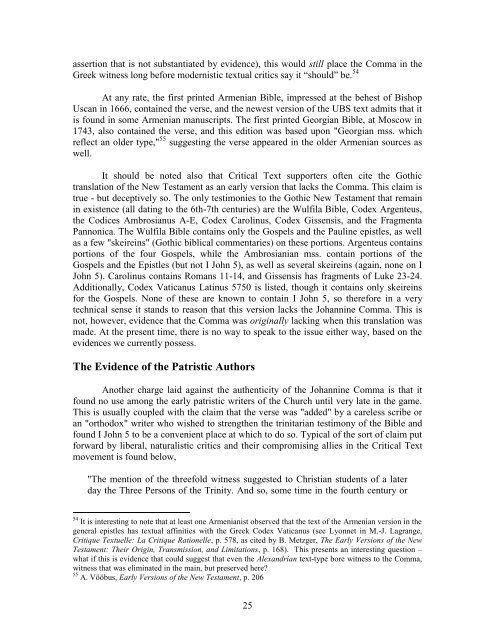A Defense of the Johannine Comma - Study to Answer.Net
A Defense of the Johannine Comma - Study to Answer.Net
A Defense of the Johannine Comma - Study to Answer.Net
Create successful ePaper yourself
Turn your PDF publications into a flip-book with our unique Google optimized e-Paper software.
assertion that is not substantiated by evidence), this would still place <strong>the</strong> <strong>Comma</strong> in <strong>the</strong><br />
Greek witness long before modernistic textual critics say it “should” be. 54<br />
At any rate, <strong>the</strong> first printed Armenian Bible, impressed at <strong>the</strong> behest <strong>of</strong> Bishop<br />
Uscan in 1666, contained <strong>the</strong> verse, and <strong>the</strong> newest version <strong>of</strong> <strong>the</strong> UBS text admits that it<br />
is found in some Armenian manuscripts. The first printed Georgian Bible, at Moscow in<br />
1743, also contained <strong>the</strong> verse, and this edition was based upon "Georgian mss. which<br />
reflect an older type," 55 suggesting <strong>the</strong> verse appeared in <strong>the</strong> older Armenian sources as<br />
well.<br />
It should be noted also that Critical Text supporters <strong>of</strong>ten cite <strong>the</strong> Gothic<br />
translation <strong>of</strong> <strong>the</strong> New Testament as an early version that lacks <strong>the</strong> <strong>Comma</strong>. This claim is<br />
true - but deceptively so. The only testimonies <strong>to</strong> <strong>the</strong> Gothic New Testament that remain<br />
in existence (all dating <strong>to</strong> <strong>the</strong> 6th-7th centuries) are <strong>the</strong> Wulfila Bible, Codex Argenteus,<br />
<strong>the</strong> Codices Ambrosianus A-E, Codex Carolinus, Codex Gissensis, and <strong>the</strong> Fragmenta<br />
Pannonica. The Wulfila Bible contains only <strong>the</strong> Gospels and <strong>the</strong> Pauline epistles, as well<br />
as a few "skeireins" (Gothic biblical commentaries) on <strong>the</strong>se portions. Argenteus contains<br />
portions <strong>of</strong> <strong>the</strong> four Gospels, while <strong>the</strong> Ambrosianian mss. contain portions <strong>of</strong> <strong>the</strong><br />
Gospels and <strong>the</strong> Epistles (but not I John 5), as well as several skeireins (again, none on I<br />
John 5). Carolinus contains Romans 11-14, and Gissensis has fragments <strong>of</strong> Luke 23-24.<br />
Additionally, Codex Vaticanus Latinus 5750 is listed, though it contains only skeireins<br />
for <strong>the</strong> Gospels. None <strong>of</strong> <strong>the</strong>se are known <strong>to</strong> contain I John 5, so <strong>the</strong>refore in a very<br />
technical sense it stands <strong>to</strong> reason that this version lacks <strong>the</strong> <strong>Johannine</strong> <strong>Comma</strong>. This is<br />
not, however, evidence that <strong>the</strong> <strong>Comma</strong> was originally lacking when this translation was<br />
made. At <strong>the</strong> present time, <strong>the</strong>re is no way <strong>to</strong> speak <strong>to</strong> <strong>the</strong> issue ei<strong>the</strong>r way, based on <strong>the</strong><br />
evidences we currently possess.<br />
The Evidence <strong>of</strong> <strong>the</strong> Patristic Authors<br />
Ano<strong>the</strong>r charge laid against <strong>the</strong> au<strong>the</strong>nticity <strong>of</strong> <strong>the</strong> <strong>Johannine</strong> <strong>Comma</strong> is that it<br />
found no use among <strong>the</strong> early patristic writers <strong>of</strong> <strong>the</strong> Church until very late in <strong>the</strong> game.<br />
This is usually coupled with <strong>the</strong> claim that <strong>the</strong> verse was "added" by a careless scribe or<br />
an "orthodox" writer who wished <strong>to</strong> streng<strong>the</strong>n <strong>the</strong> trinitarian testimony <strong>of</strong> <strong>the</strong> Bible and<br />
found I John 5 <strong>to</strong> be a convenient place at which <strong>to</strong> do so. Typical <strong>of</strong> <strong>the</strong> sort <strong>of</strong> claim put<br />
forward by liberal, naturalistic critics and <strong>the</strong>ir compromising allies in <strong>the</strong> Critical Text<br />
movement is found below,<br />
"The mention <strong>of</strong> <strong>the</strong> threefold witness suggested <strong>to</strong> Christian students <strong>of</strong> a later<br />
day <strong>the</strong> Three Persons <strong>of</strong> <strong>the</strong> Trinity. And so, some time in <strong>the</strong> fourth century or<br />
54 It is interesting <strong>to</strong> note that at least one Armenianist observed that <strong>the</strong> text <strong>of</strong> <strong>the</strong> Armenian version in <strong>the</strong><br />
general epistles has textual affinities with <strong>the</strong> Greek Codex Vaticanus (see Lyonnet in M.-J. Lagrange,<br />
Critique Textuelle: La Critique Rationelle, p. 578, as cited by B. Metzger, The Early Versions <strong>of</strong> <strong>the</strong> New<br />
Testament: Their Origin, Transmission, and Limitations, p. 168). This presents an interesting question –<br />
what if this is evidence that could suggest that even <strong>the</strong> Alexandrian text-type bore witness <strong>to</strong> <strong>the</strong> <strong>Comma</strong>,<br />
witness that was eliminated in <strong>the</strong> main, but preserved here?<br />
55 A. Vööbus, Early Versions <strong>of</strong> <strong>the</strong> New Testament, p. 206<br />
25


